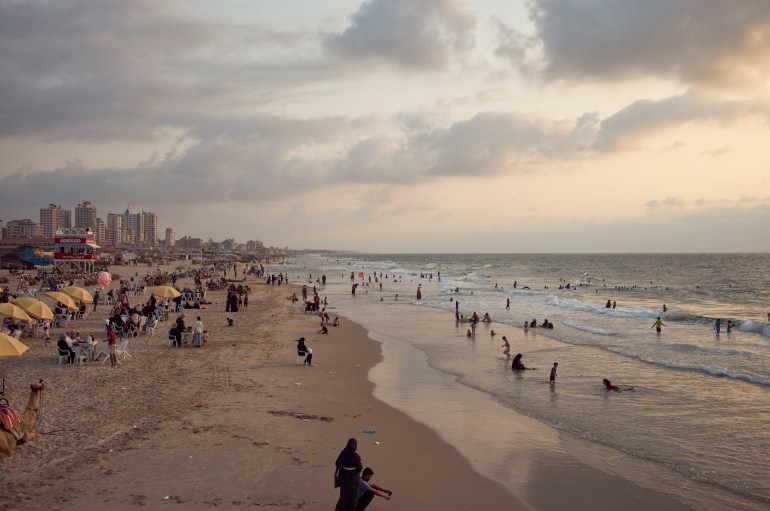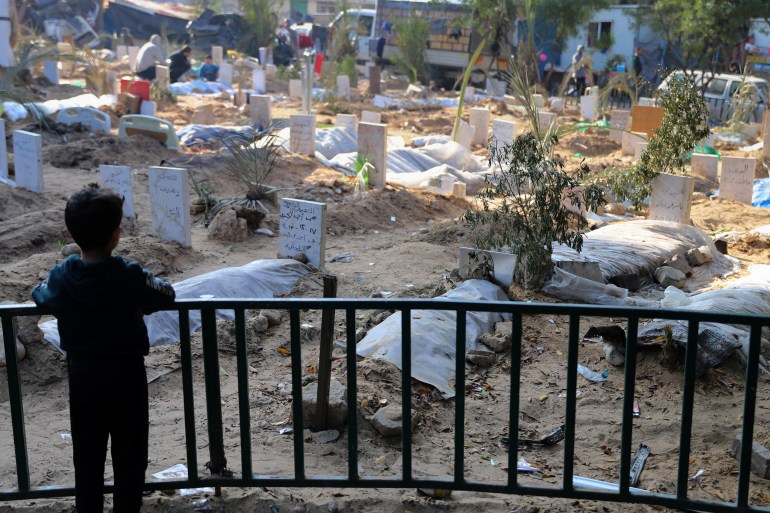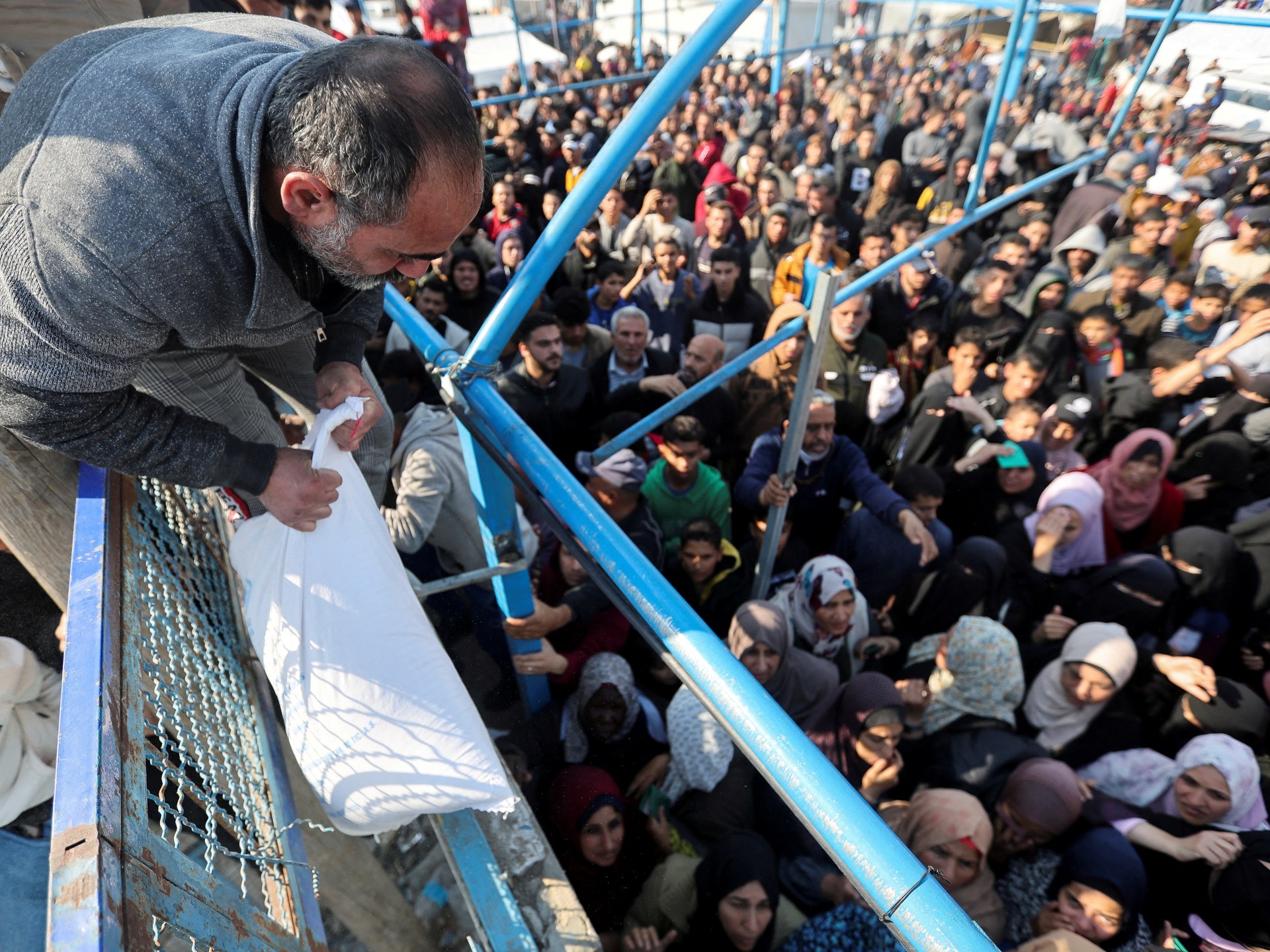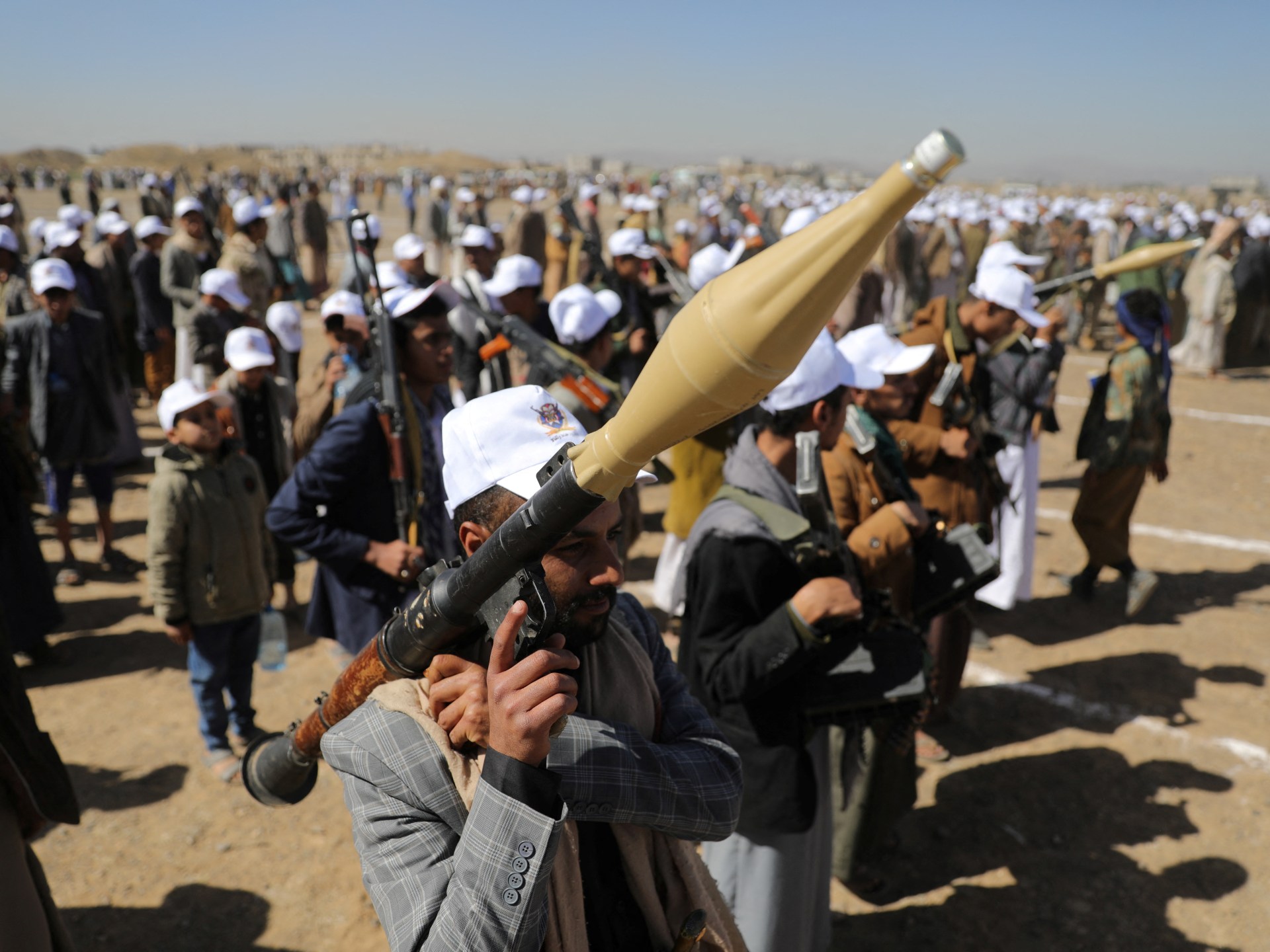‘Devastated, heartbroken’: Against the odds, Gaza aid providers keep going | Israel War on Gaza
When Hussam Okal sought shelter with his family at a training centre in the southern Gaza city of Khan Younis in October, the United Nations Relief and Works Agency for Palestine Refugees (UNRWA) staffer found the place full with an estimated 22,000 people searching — like him — for safety from Israeli bombs.
“We’re working on two sides. On the one side, we’re trying to keep our families safe, and on the other, we’re trying to serve the displaced people,” he said at the time. “As UNRWA staff, we carry a humanitarian message to try to offer as much assistance as we can.”
It is a task that the UN agency has performed since 1950 in the Gaza Strip, the occupied West Bank, Jordan, Lebanon and Syria, serving as a lifeline for Palestinians. It runs schools, health programmes and more for the Palestinian refugees and their descendants who have been deprived of their homeland since the Nakba when 750,000 Palestinians were forced out of their land during the 1948 creation of Israel.
For decades, its UN blue logo has been a source of support for Palestinians. Now, in Gaza, it is struggling to fulfil its mission, in a war where the UNRWA has suffered like never before.
At least 146 UNRWA staffers have been killed in Israeli bombings, the highest-ever death toll for any UN agency in a war. Others have lost their homes and family members. Like Okal, they have been forced to seek safety in schools and training centres their own teams set up in the past. The war is scarring the agency — and its leadership is not immune.
“I am devastated and heartbroken for the people of Gaza,” Thomas White, the head of the UNRWA in Gaza, told Al Jazeera in an interview. “I don’t quite know how to deal with the emotions of the most profound sense of loss of staff members and community that you know. Gaza is grieving,” White said.
‘Starved of resources’
The UNRWA has worked with Palestinians through the multiple wars and waves of displacement they have endured over the past 74 years.
Yet, the current war is unlike any the agency has witnessed. “UNRWA have planned and rehearsed for such eventualities, we know what we need to do,” White said. “However the scale of death and destruction in such a short time frame, compounded by the fact everyone is trapped in Gaza, with nowhere that is safe, and we are effectively being starved of resources – which has made this enormously difficult.”
Still, how the UNRWA copes with the crisis could prove critical for Gaza’s 2.3 million people, who have suffered a devastating bombing campaign by Israel since October 7, when Hamas fighters launched a surprise attack on southern Israel, killing 1,139 people. Israeli bombardment has killed more than 23,000 Palestinians in Gaza, including nearly 10,000 children.
The current war has already displaced more than twice the number forced from their land in 1948: an estimated 1.9 million people have had to leave their homes since October 7. The agency has reported that 1.4 million internally displaced people (IDPs) are sheltering across 155 UNRWA-run facilities, primarily schools.
That includes UNRWA staffers who must settle their spouses, children, siblings and parents, then turn to help the hundreds, sometimes thousands, who had come to the same place for help.
“We’re working in terrifying life conditions,” said Okal. “Whenever there is an air raid nearby, you can hear children of all ages screaming and the adults trying to calm them down.”

‘In memory’
Before the war, a typical day for White would involve meeting key team members, heading out to visit UNRWA staff at the agency’s schools or health clinics and meeting people living in refugee camps.
But on October 13, the agency evacuated from Gaza City to a logistics base in Rafah in the south of the strip amid the bombing. From there, White has been watching his agency come under attack.
Latest reports from the UNRWA indicate that 132 installations have been damaged, including 63 that took direct hits. In addition, 52 schools sustained damage and 53 took direct hits.
In times of war, the UN and its agencies are usually treated as neutral players and peacemakers by all sides. This time, it is different.
Gilad Erdan, Israel’s permanent representative to the UN, has publicly accused UNRWA staffers of links to Hamas. He argued that “the influence of Hamas is so pervasive that it taints the objectivity of reporting and statistics provided”.
White, who has led humanitarian operations in Afghanistan, Iraq, Lebanon, Syria, Libya, Rwanda, East Timor and the occupied West Bank, refused to be drawn into comment on allegations made by Israel’s envoy to the UN. “All we are focussed on right now is doing our job for the people of Gaza in exceptionally difficult circumstances.”
Last month, Qatari Emir Sheikh Tamim bin Hamad Al Thani presented the Doha Forum Award to UNRWA Commissioner-General Philippe Lazzarini, honouring the agency staff for their humanitarian work in Gaza and throughout the region.
UN convoys delivering aid in the north of the enclave have come under fire from Israeli forces, despite being clearly marked “UN” and prior coordination to ensure that they would be protected.
“This award is in recognition of the lifesaving and irreplaceable work that my colleagues are doing, especially in the Gaza Strip and across the region,” said Lazzarini.
White said, “The majority of the staff have been displaced from the north with their families, and are now living in IDP shelters themselves. But, they still show up to work every morning and put in a solid day and do an impossible task, despite being exhausted.”
“They give me strength.”

‘Don’t recognise the north any more’
Like the UNRWA staff, a majority of the people of Gaza have been forced to leave the north of the enclave, now largely a dystopian wasteland of millions of tonnes of conflict debris.
White, who was posted to Gaza two and half years ago straight from Afghanistan before the fall of Kabul, said, “The damage is so severe I don’t recognise the north any more. You lose your bearings because all the landmarks have gone.”
North of Wadi Gaza, relatives of the “missing” who still lie buried, entombed in a mass of shattered concrete and contorted steel, hover where their homes once stood, listening, in hope for a miracle and searching for memories. An estimated 8,000 civilians are reported missing, feared dead, buried beneath the rubble, according to Gaza’s Ministry of Health.
The UNRWA’s struggles are mirrored in the experiences of other leading aid providers too.
Khalid al-Hardan, vice chairman of the Qatar Committee for the Reconstruction of Gaza (QCRG) who has spent more than a decade overseeing the implementation of substantial Qatari-funded projects in Gaza, said the damage sustained in this war, compared with previous wars, was simply staggering. The QCRG’s projects in Gaza include hospitals, arterial roads, law courts and housing.
“People in Gaza have the right to live like any normal human being, educate their children, support their families, travel without restriction and live in peace. They deserve better than this,” said al-Hardan, speaking from Gaza.
The QCRG is already aware of severe damage to projects it has supported. The Palace of Justice — Gaza’s main court — located in az-Zahra, has been destroyed along with several parts of al-Rashid road along the strip’s beachfront.
Sheikh Hamad bin Khalifa Hospital completed in 2019 – funded by Qatar Fund for Development (QFFD) – which designs and manufactures the most advanced prosthetics for those injured by conflict and accident, or born with congenital defects – has also been heavily damaged.
QCRG’s main office based in northern Gaza sustained heavy damage caused by Israeli soldiers who entered the property despite several official warnings not to. The committee has since relocated its operation south, near the Rafah crossing with Egypt.
Al-Hardan said all QCRG suppliers and contractors are vetted and approved by all parties involved, including the UN and Israel, and projects are implemented on the understanding they are classified as “civilian” infrastructure and will not be targeted in war.
Still, on December 2, the Hamad housing complex in the city of Khan Younis, which was inaugurated in 2016 and was one of the committee’s most recent projects, was attacked by Israeli air raids, destroying four entire apartment blocks. More than 1,000 of the accommodation units had been provided to Palestinians displaced by Israel’s war on the enclave in 2021. Al-Hardan called the attacks “shameful”.

‘The greatest challenge’
Last week, UN experts said “more than two million Palestinians do not have enough food and half of the population are now starving” as Israel continues its deadly bombardment of the enclave.
On average, White said, 100 aid trucks are crossing over into Gaza every day now. That is nowhere near enough: by comparison, 500 trucks were crossing into the strip during the 51-day war in 2014. “We have accumulated such a large deficit that the situation may never recover.”
That backlog is evident, White said, when he drives through camps for Gaza’s displaced people every afternoon. Some camps have as many as 40,000 people, exposed to a deepening winter, without sanitation or clean drinking water.
“When the winter storms come through, it’s going to be devastating there for those in temporary structures of wood and plastic. It is a disaster waiting to happen,” he said.
Food aid remains in short supply, too. “We are predominantly distributing wheat flour, but we only have enough stocks for 24-48 hours on the ground,” White said. “For example, today we are down to 4,000 bags of wheat flour, which will assist 4,000 families, and that’s it. There is no more.”
“Some of our staff have suffered such huge personal loss and we can’t even support them with sufficient humanitarian needs.”

Resources drying up
The UNRWA provides critical services, including education, healthcare, relief and social services, microfinance, infrastructure and camp improvement, as well as emergency food assistance.
However, increasing needs and cost of operations have put significant pressure on the agency, which has long reached the limits of its ability to manage the chronic underfunding of the last 10 years through cost control, austerity measures and debt accumulation.
To be sure, several nations such as Norway, Japan, Germany and the Gulf states are — in addition to contributing to the UNRWA — also implementing infrastructure projects on their own.
Qatar has stepped up. It has contributed $74m to the agency over the past five years. The country, a linchpin in mediating the humanitarian pause in the war, has also directly invested $2.1bn in the Gaza Strip since 2012.
Yet Qatar too has faced obstacles in getting aid into Gaza during the war. “Getting aid into Gaza has been the most challenging task for the State of Qatar and QFFD due to various factors related to the complex political, social, and security situation in the region,” QFFD Director-General Khalifa Jassim al-Kuwari said. “Amid a relentless war machine that ravages and extinguishes life in Gaza, QFFD will continue to provide crucial assistance to the people of Gaza despite the ongoing challenging situation.”
Medical essentials are a key focus of additional supplies that the fund plans to send to Gaza, al-Kuwari said. “Our collaborative approach involves working closely with local non-governmental organisations, including Qatar Red Crescent and Qatar Charity, as well as partnering with other local and international entities,” he said.
“It is truly painful to see the ongoing conflict, which has resulted in immense suffering for Palestinians including women and children. We are aware of the difficulties of our mission, yet we remain steadfast – particularly in the face of this urgent emergency – to ensure that aid reaches those who need it most and saving lives,” al-Kuwari added.
The Israeli cabinet, facing mounting international condemnation for restricting aid to the enclave, last week opened the Karem Abu Salem (called Kerem Shalom by Israelis) crossing to alleviate the aid bottleneck at the Rafah border to meet their commitment of 200 trucks of aid each day. It is a promise that has not been kept to date.
Even before the war, the economic and social blockade of the Gaza Strip had fuelled one of the highest unemployment rates in the world at nearly 50 percent — and 70 percent among young people. Almost 81.5 percent of the population lived below the poverty line, 700,000 lived in abject poverty and 40 percent of the population did not have enough food.
That landscape has now turned even more dreary.
UN figures as of December 30 reported that nearly 70 percent of Gaza’s housing units had been damaged or destroyed, 352 schools were damaged and the remaining educational facilities were providing shelter to those displaced. Half of Gaza’s hospitals are out of service, and civic infrastructure, factories and businesses have suffered damage.
Lazzarini, who wrote to the president of the UN General Assembly last month, warned that UNRWA’s ability to fulfil its mandate in Gaza is severely limited. The entire humanitarian response heavily relies on the agency’s capacity, which is now on the verge of collapse.
However, White explained to Al Jazeera, stopping is not an option. “I have told our staff that despite not having the resources in hand to meet the needs of people, we will continue working to the last bag of flour and the last drop of fuel.”
White said he was proud of the work his “incredible team here in Gaza” had put in to bring “first-rate schools and health clinics” to the people of the enclave.
“In the space of nearly 10 weeks, it has all been destroyed. It’s incredibly sad really,” he said.
When asked what future if any for Gaza will exist when the war ends, White explained that planning too far ahead for the future is a luxury he and his team cannot afford.
“We are simply focused on today and tomorrow,” he said.
Al-Hardan who has spent years with his teams meticulously understanding the full extent of Gaza’s dilapidated civic infrastructure explained that if Israel continues, unrestrained, and at its current pace of destruction, Gaza could reach the point of no return.
“However, with an immediate and meaningful ceasefire this can be avoided,” he said. “But, it needs the will and desire of the free world, international community and in particular the US to pressure Israel to allow reconstruction materials to flow back into the strip.”
Check out our Latest News and Follow us at Facebook
Original Source







